The explanation regarding the origin and characteristics of Mars’ satellites has been a subject of speculation, intrigue, and ancient tales. At one point, Phobos and Deimos were even associated with extraterrestrial spacecraft. Furthermore, scientists have hypothesized that the number of Earth’s twin satellites might have varied in the past.


The Discovery of Mars Satellites
In 1611, the renowned German astrophysicist Johannes Kepler proposed the idea that Mars is accompanied by two satellite bodies. This hypothesis was based on the writings of Galileo Galilei, who mentioned observations of a triple planet. It was later understood that Galilei’s description actually referred to Saturn and its famous rings.
Although Kepler’s assumption was initially incorrect, it turned out to be true. In honor of the astronomer, craters on Mars and the Moon have been named after him.
In 1726, Jonath Swift’s book “Gulliver’s Journey” featured calculations of physical parameters for Mars’ satellites, which were purely based on his imagination. Interestingly, eight craters on Phobos’ surface are now named after characters from this work.
The discovery of Mars’ moons was made by Asaph Hall.
In the 16th century, observatories across Europe were perplexed in their search for the neighboring planet’s moons. However, it was not until August 11 and 17, 1877, that Deimos and Phobos were officially discovered by Asaph Hall in the United States. This remarkable achievement was made possible during a period of maximum convergence between our planet and its neighbor, which occurs every 15 years.
How the Moons of Mars Got Their Names
In February 1878, after an extensive search for suitable names, Phobos and Deimos were officially named by Hall. He reached out to numerous figures in the scientific community, and out of the many suggestions, he selected Henry George Madan’s proposal. Madan, in turn, took the names from Homer’s Iliad. Alternatively, it is believed that an unidentified schoolgirl from Great Britain came up with these names.
Many names in the solar system, including asteroids, stars, and other celestial bodies, derive from ancient mythology. The Red Planet, known for its aggressive surface color, was symbolically named after the ancient Roman god of war. In Greek mythology, this god was called Ares. Despite symbolizing cruelty, strength, and a fondness for war, Ares was highly revered. It is no surprise, then, that the moons of the planet Mars were named after the children of the Greek god of war.
According to Greek belief, Ares was always accompanied by his children with Aphrodite in battle. This is why the moons are named Phobos and Deimos, meaning fear and terror, respectively.
How many moons does Mars have
The number of moons orbiting Mars remained a mystery until 1877. Despite the calculations made by astronomers, which suggested the existence of celestial bodies circling the neighboring planet, it was widely believed that Mars had no natural satellites because they had not been observed. The discovery of these objects caused a sensation in the scientific community.
It has since been confirmed that the planet Mars has two natural moons, known as Phobos and Deimos. Phobos is situated in the inner orbit of the planet, at an average distance of 9380 km, while Deimos is located two and a half times farther away.

Phobos
Phobos is an inner satellite of Mars, located 9380 km away from the planet. It appears three times in the Martian sky every day, moving from west to east. With dimensions of 26.8×22.4×18.4 km, Phobos is three times smaller than the Moon as seen from Earth.
The surface of Phobos bears traces of collisions with small asteroids and comets. It features deep and wide furrows and craters, which can be attributed to its porous structure. According to NASA calculations, the soil structure of Phobos can contain voids up to 45%. The largest crater on Phobos is named Stickney Hall, after the wife of the person who discovered the Martian satellites. This crater is so large that it can be observed with the naked eye from Mars. Inside Stickney, there is a smaller, younger crater.
Deimos
Deimos is an inner moon of Mars with a unique shape and smooth surface. It has dimensions of 15×12.2×10.4 and is located at a distance of 23460 km from Mars. Unlike its brother moon Phobos, Deimos is smaller and appears as a white star in the sky, similar to Venus seen from Earth. It completes one orbit around Mars from east to west each day.
Deimos and Phobos have a synchronous rotation with respect to Mars, meaning that they always show the same face towards the planet. This is a common characteristic among natural satellites in our solar system. However, even with this orbital configuration, tidal forces still have an impact on these bodies. This can be observed through phenomena like tides on Earth or the gradual approach of Phobos to Mars, which occurs at a rate of about 10 cm per year.
The Origins of the Moons of Mars
Astrophysicists are of the belief that the Martian moons have their origins in a massive impact with an unidentified celestial object. It has even been determined that the planet was struck by a colossal asteroid, resulting in the formation of a crater in the region known as Ellados. According to this theory, the collision was so forceful that the asteroid passed through the planet, emerging in the northern hemisphere. This event not only caused changes to the planet’s surface and soil composition, but also ejected a significant amount of debris and dust containing heavy metal particles into orbital space. Over time, these natural space remnants coalesced to form either one or two bodies that were subsequently captured by Mars’ gravitational pull.
As for an alternate interpretation of Mars’ natural satellites, Phobos and Deimos, they took shape as ellipsoidal bodies during the same era that the planets in our solar system formed from cosmic debris. This theory suggests that the planet and its Martian moons existed within their own independent system, which allowed for the creation of a unique microenvironment.
Hypothesis of Formation as an Alternative
Among the scientific community, there are individuals who hold the belief that the Martian satellites are actually extraterrestrial spacecrafts. One devoted advocate of this theory was the Soviet astrophysicist I.S.Shklovsky. In his writings, he referred to the physical characteristics of Phobos, suggesting that it is nothing more than an abandoned aircraft from an advanced alien civilization. He argued that the object is hollow inside, and the surface damage is not the result of meteorite collisions but rather intentional bombardment, which caused it to fall into disrepair. To support his claims, he advocated for the release of all research findings on the satellites conducted by NASA spacecraft. In honor of his contributions, a crater on the surface of Phobos was named after this esteemed Soviet astronomer.
Nevertheless, the precise source of the satellites remains unknown up to this point, as it remains impossible to definitively determine the reasons behind the formation of the Moon or the entire solar system as a whole.
The third Martian satellite, Thanatos
The current orbital trajectory of Phobos suggests that it is on the brink of destruction, as it has already crossed the critical point known as the Roche limit. At this stage, the moon is constantly subjected to gravitational forces from the planet, which gradually reduce its range of motion. This ongoing process could ultimately result in either a catastrophic explosion or a descent onto the planet’s surface. Both outcomes would have irreversible consequences for Mars, ranging from significant changes to its geological landscape to partial destruction. However, the complete demise of Phobos is estimated to be at least 12 million years away. The observations of this phenomenon have sparked the development of the theory that Mars may have had three satellites in the past.
Among the most conventional theories, there is a belief that the demise of Thanatos led to the annihilation of all life on the adjacent planet, altering the landscape, decimating the atmosphere, and transforming Earth’s twin into a barren wasteland of space, inhospitable for any form of life. However, these are merely audacious suppositions of proponents of the notion of human colonization of Mars.
As can be observed, investigations of the satellites of the crimson planet remain confined to the realm of conjecture and hypotheses. A thorough examination of these entities has the potential to revolutionize the fields of cosmology and astrophysics, but the timing of such a breakthrough remains uncertain.
Did you find the information helpful? Share it on social media!
Mars is home to two moons, Phobos and Deimos. These two satellites are thought to be asteroids that were captured by the gravitational pull of Mars. They were discovered in the 1870s and were named after Greek gods. One interesting fact is that Phobos is slowly getting closer to Mars, while Deimos is moving further away. These moons are unique in our solar system. Let’s learn more about them in this article.
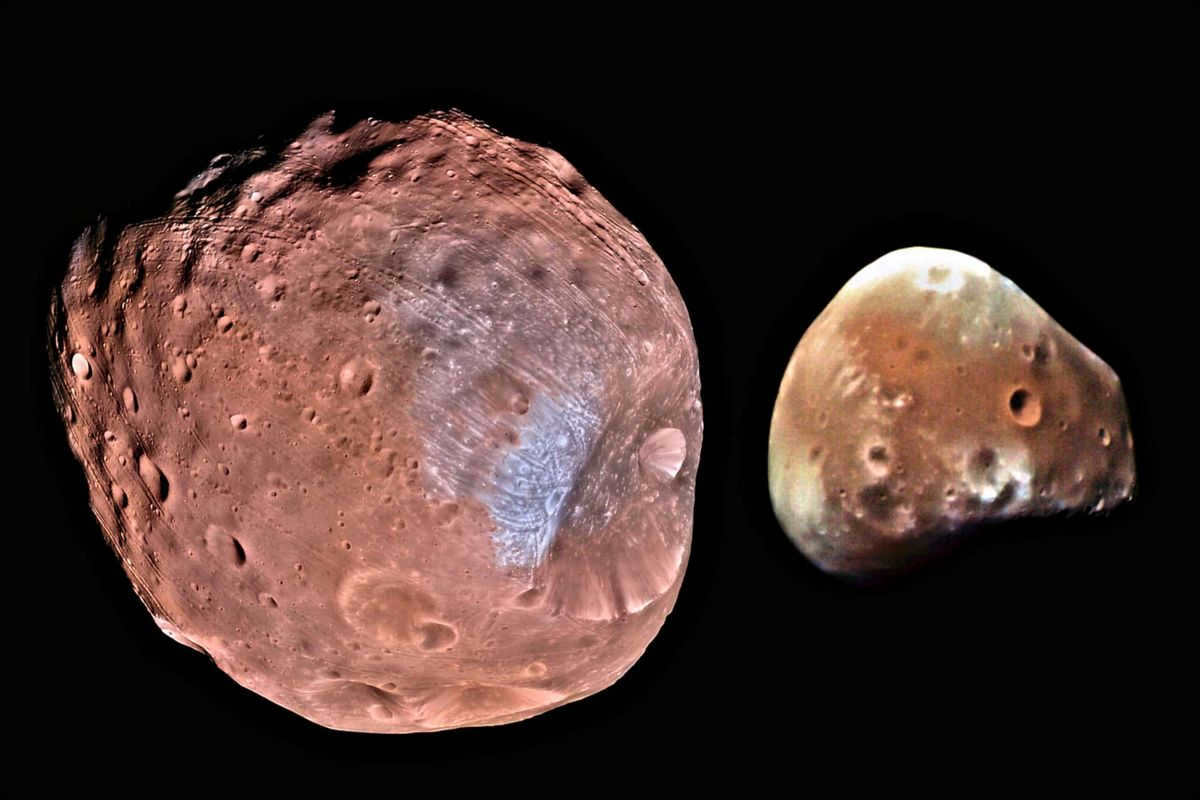
Discovery of the Moons of Mars
In the late 18th century, the first attempt was made to locate the moons of the fourth planet in our solar system. Throughout the 19th century, German astronomers diligently searched for these Martian satellites. However, despite their efforts and the use of telescopes equipped with refractors, they were unable to detect them.
In J. Swift’s novel “Gulliver’s Travels,” he references the moons of Mars. Swift states that Phobos has an orbital period of 10 hours, while Deimos has an orbital period of over 21 hours. During the early 17th century, astronomer I. Kepler misinterpreted Galileo Galilei’s observations and mistakenly believed that Mars had three moons (it was actually Saturn). Kepler made a prediction about the number of moons Mars had, correctly stating that there were two celestial bodies.
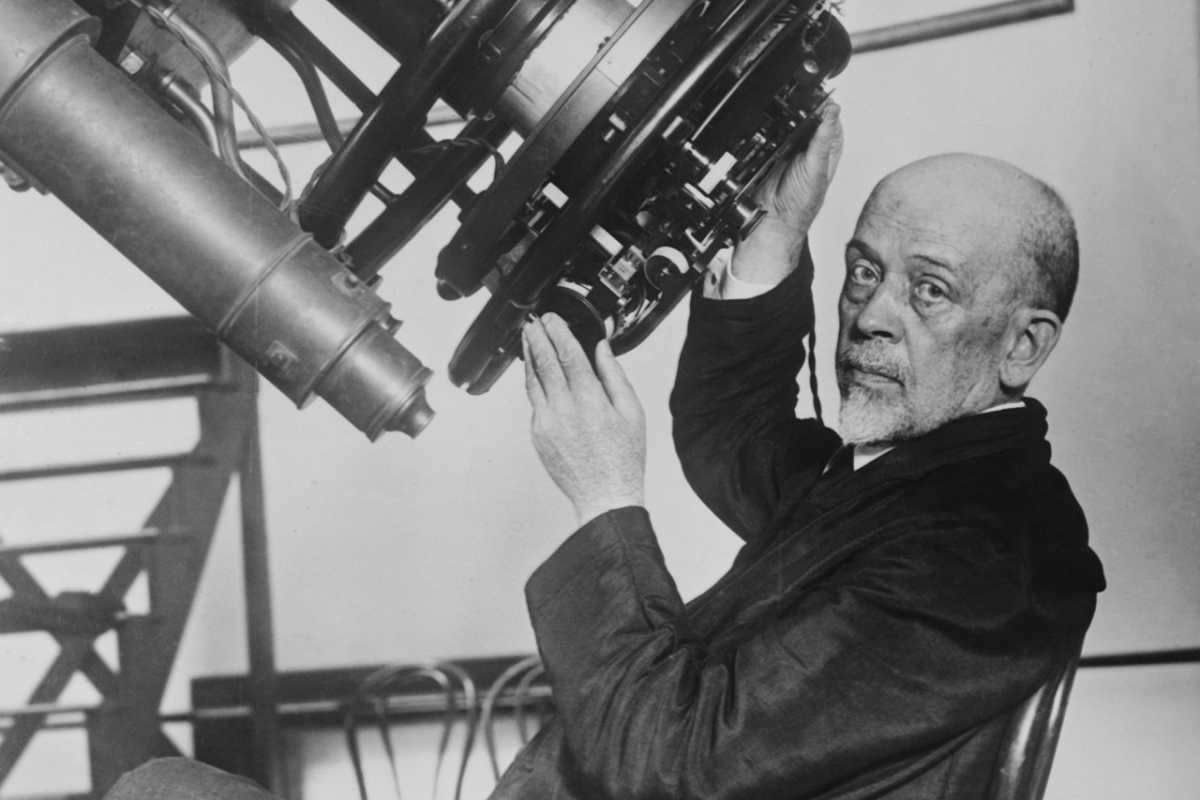
During the year 1877, when Mars was closest to Earth, Asaph Hall, an astronomer at the U.S. Observatory, made a remarkable discovery. Using the most advanced telescope of that time, he found two satellites orbiting Mars. To honor their significance, astronomer Henry Madan gave them names inspired by Greek mythology. One was named Phobos, after the Greek god of fear, and the other was named Deimos, after the Greek god of terror. According to ancient myths, these moons were said to accompany Ares, the god of war, into battle. In Roman mythology, Ares was known as Mars, and hence the connection to the red planet.
| Martian Satellites | Main Characteristics |
| Phobos | Size: 27 × 22 × 18 km Orbit: Close to Mars, synchronous with Mars’ rotation Composition: Likely carbonaceous chondrites |
| Deimos | Size: 15 × 12 × 11 km Orbit: Further from Mars, not synchronous with Mars’ rotation Composition: Likely carbonaceous chondrites |
| Characteristics of Mars’ Satellites | Phobos | Deimos |
| Size of Orbital Semi-Major Axis | 9,377 kilometers | 23,458 kilometers |
| Eccentricity | 0.0151 | 0.0002 |
| Orbital Period | 7 hours 39 minutes | 1.26 days |
| Dimensions | 26.8 × 22.4 × 18.4 kilometers | 15 × 12.2 × 10.4 kilometers |
| Average Distance from Mars | 6,000 kilometers | 23,400 kilometers |
| Diameter | 22.5 kilometers | 12.4 kilometers |
| Radius | 11.27 kilometers | 6.2 kilometers |
| Mass | 10.7 trillion tons | 1.48 trillion tons |
| Free-Fall Acceleration | about 0.001 m/s² | about 4 mm/s² |
Phobos circles around Mars at a velocity of 7 meters per second. If the speed of the satellite was reduced, it would descend towards the planet, whereas if it was increased, it would escape into the vastness of outer space.
Phobos is gradually approaching Mars at a rate of approximately 1.8 centimeters per year. Preliminary computations indicate that in 43 million years, the satellite will plummet onto the surface of the Red Planet. However, well before that occurs, it will disintegrate into multiple fragments due to the gravitational pull of the planet.
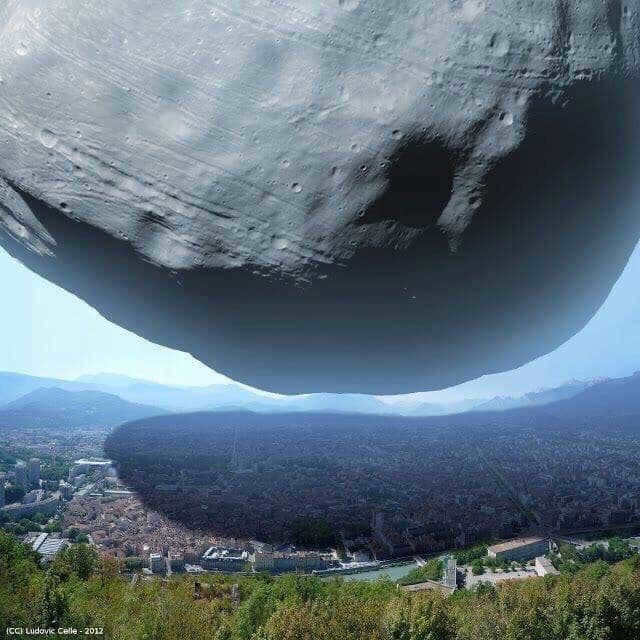
One of the most easily identifiable features on Phobos is the Stickney crater. It measures 9 kilometers in diameter and is believed to have been created by a collision between Phobos and an asteroid. The satellite also exhibits grooves, which can be up to 20 meters deep, 200 meters wide, and 30 kilometers long. In 1998, astronomers discovered a large rock formation on Phobos, standing at approximately 90 meters in height.
The Stickney Crater is visible to the naked eye from Mars.
Deimos features a more level and sleeker surface with significantly fewer craters. Additionally, unlike Phobos, it lacks any surface faults. Astronomers have identified two craters on Deimos: Swift, which measures 1 kilometer in diameter, and Voltaire, which has a diameter of 0.9 kilometers. These craters are named in honor of writers who made references to the Martian moons prior to their discovery by astronomers.
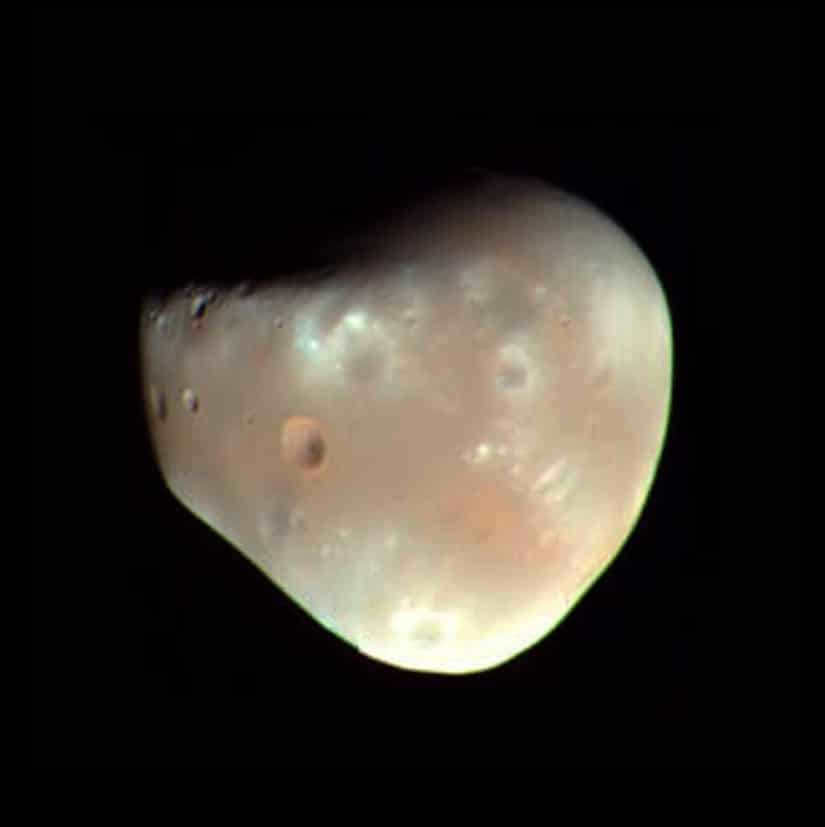
The Mars satellite is gradually moving away from the planet. It is anticipated that in the distant future it will venture beyond the influence of Mars.
Composition
Both satellites consist of solid rock. The surface is coated with a substantial layer of regolith. The satellites endure frequent bombardment from meteorites.
The Composition of Phobos
Based on scientific studies, Phobos is composed of a collection of large rocks that are held together by the force of gravity. These rocks are covered by a layer of regolith, which is approximately 100 meters thick. Regolith is a type of soil that forms on the surface of celestial bodies through various processes, including weathering. It consists of fragments of rocks that have been deposited on the surface due to volcanic activity, meteorite impacts, and other factors.
Spectral analysis has revealed that the soil on Phobos belongs to the C-chondrites class, which is commonly associated with asteroids. Additionally, traces of phyllosilicate, a mineral that forms with the presence of water, have also been detected on the surface.
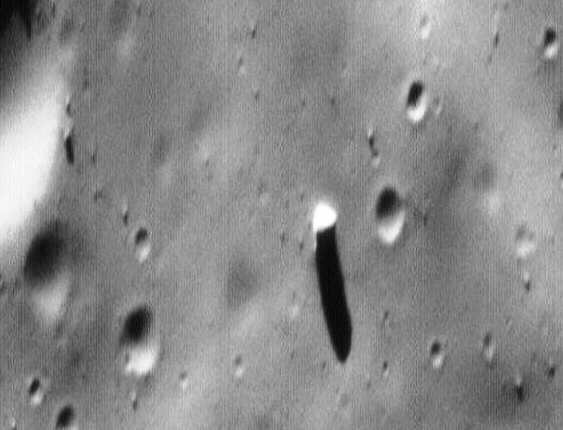
Empty space accounts for 25 to 45 percent of Phobos’ volume. Due to the unsuccessful space mission, determining the precise chemical makeup of the satellite was not possible.
It is believed that this Martian satellite is made up of the same components as Phobos. Internally, it contains significant quantities of carbon-rich rocks and ice. Additionally, it is coated with a thick layer of regolith.
Deimos and Phobos are perpetually facing one side of Mars. They rotate around their axis at the same rate as they orbit Mars, making them reminiscent of the Moon.
The origin of the Martian moons
There isn’t a single theory regarding the formation of the Martian moons. The primary theory proposes that Phobos and Deimos were captured from the asteroid belt due to gravitational forces. Initially, they followed an elliptical orbit, and over time, tidal forces shaped their current trajectory.
Currently, there are no definitive hypotheses explaining the exact process of satellite capture.
An alternative theory of satellite formation suggests that in the past, Mars was surrounded by numerous celestial bodies of comparable size to the current moons. These bodies were expelled into Martian orbit after colliding with a massive space object.
The alternative theory is supported by the porosity and relatively low density of Phobos. Phyllosilicates, which are abundant on the surface of Phobos, are frequently found on the surface of Mars. It is believed that the satellites formed when the planet collided with an asteroid and ejected matter into orbit.
Another hypothesis suggests that Phobos and Deimos are fragments of a larger, previously existing satellite. This satellite is thought to have collapsed between 1-2.7 billion years ago due to a cosmic collision. The unusual shape of Phobos and Deimos, resembling asteroids, supports this theory. However, their nearly circular orbits around Mars are typical of satellites.
Influence of Mars on Satellites
The gravitational pull of Mars affects the Martian moons. This leads to tidal forces that cause the moons to always face one side of Mars. As a result of these forces, Phobos is gradually moving closer to the planet. Over time, the interaction between Phobos and Mars will continue to increase, eventually causing the satellite to disintegrate. This is evident from the presence of deep craters on Phobos’ surface.
On the other hand, Deimos is experiencing a gradual expansion of its orbit. This phenomenon is also observed with Earth’s moon.
In Greek mythology, there existed a deity known as Ares, who was considered the god of war. Ares held the belief that war was the ultimate purpose of life, which caused him to be disliked by the other gods. Despite this, Ares possessed an extraordinary handsomeness that captivated Aphrodite, the goddess of beauty, and she fell deeply in love with him.
From their passionate love affair, a son named Phobos, who later became known as the god of fear, was born. Phobos would often accompany his father Ares in military battles, instilling fear into the hearts of their enemies. Additionally, Ares and Aphrodite bore several other children:
- Deimos, who became the god of terror;
- Anteros, who became the god of hate;
- Eros, who became the god of love;
- Himeros, who became the god of passion;
- Harmonia, who became the goddess of harmony and embodiment of marital happiness.
Phobos is often depicted with the head of a lion on the shield of Agamemnon, the king of Mycenae and one of the central figures in the epic poem, the Iliad.
Observing Satellites from Mars
The satellites can be easily seen from the surface of Mars. Phobos is most visible near the equator of the planet, appearing about three times smaller than the Moon in the Earth’s sky. As the observer moves farther away from the equator, Phobos appears even smaller and eventually becomes invisible in the polar cap region.
Phobos rises in the west and sets in the east, reappearing in the sky after approximately 11 hours. The Stickney crater on Phobos can be seen with the naked eye. Deimos, on the other hand, takes almost three days to cross the sky. It is possible to see both Martian moons in the sky simultaneously, with Phobos gradually catching up to Deimos.
Deimos is smaller than Phobos and is situated at a greater distance. It appears as a luminous celestial body in the Martian atmosphere (shinier than Venus in the Earth’s atmosphere with a star magnitude of -5). Due to the relatively small size of the moons, there are no complete solar eclipses on Mars, but nearly every night there is a passage of Phobos across the Sun’s surface.
Phobos and Deimos emit a relatively bright glow in the Martian nighttime sky. When objects are illuminated by them, they can create distinct shadows.
Solar eclipses observed on Mars
Eclipses happen when one of Mars’ moons passes in front of the Sun, causing the Sun’s light to be blocked. Due to their small size, Phobos and Deimos cannot cast a shadow on Mars that would be visible from Earth. However, after an artificial satellite was placed in Mars’ orbit, scientists were able to witness the shadow created by Phobos.
Due to the small size of this satellite and its rapid orbit around Mars, the duration of a solar eclipse is limited to a maximum of 20 seconds. With an orbital period just over 7.5 hours, it is possible to have two annular eclipses of the Sun in a single day.
Deimos is too small and too far from Mars to cause a solar eclipse. However, on Mars, it is possible to observe Deimos passing across the solar disk. The maximum duration of this celestial event is 2 minutes.
The third moon of Mars, Thanatos.
Phobos is steadily approaching the critical Roche limit. Once it surpasses this limit, the moon will inevitably be destroyed (or it may come to a halt and fall onto Mars). The fall of Phobos will result in significant and irreversible changes to the surface of Mars.
Phobos and Deimos: Fascinating Trivia
Phobos and Deimos, the enigmatic satellites of Mars, possess a host of intriguing characteristics. Explore these captivating tidbits about these Martian moons.
- Phobos and Deimos exhibit irregular shapes that are absent in any other celestial bodies within our solar system. In fact, they bear a striking resemblance to potatoes when captured in images.
- A significant number of space missions aimed at investigating the Martian moons have met with failure.
- The gravitational pull experienced on the surface of Deimos is a mere 2.5 thousand times fainter than that of Earth.
- Phobos holds the distinction of being one of the dustiest locales in our solar system.
- Curiously, Phobos showcases small grooves that serve as early indicators of its eventual disintegration under the sway of Martian gravity.
Phobos and Deimos, the moons of Mars, are the smallest in the entire solar system. Despite being discovered relatively late, they possess numerous enigmas yet to be unraveled. A thorough examination of the composition and structure of these celestial bodies could potentially shed light on the mysteries that the solar system conceals.

Scientists have been intrigued by the peculiar shapes and colors of the Martian satellites Phobos and Deimos, which has led them to question their origins. The dark surfaces of these moons bear a striking resemblance to primitive asteroids found in the outer reaches of our solar system, leading to the hypothesis that these asteroids were once captured by Mars’ gravitational pull. However, upon closer examination of the orbits of these satellites, it becomes clear that the capture scenario is not supported.
Recent analysis of data collected by the Mars Global Surveyor mission, which dates back over 20 years, provides new insights into the formation of Mars’ satellites. This research suggests that these moons were formed as a result of a massive impact event that shook the planet, causing a multitude of rocks to be launched into orbit.
As per a research study published in the Journal of Geophysical Research: Planets by the American Geophysical Union, it has been revealed that the data set holds significant indications about the composition of Phobos, suggesting that it could share more similarities with the Martian crust than previously thought.
What is the origin of Mars’ satellites?
“I find it fascinating to uncover untapped potential in old datasets,” expresses Tim Glotch, a geologist from Stony Brook University in New York City and the main researcher of the recent study.
Mark Fries, a planetologist and curator of cosmic dust at the Kennedy Space Center in New York City, is the primary author of the recent study. NASA’s Johnson, not involved in the study, states that the lack of understanding about moon formation among scientists is the reason behind the failure to explain the origin of the two satellites on a neighboring planet. Gaining this understanding will aid in interpreting the appearance of other moons within and beyond our solar system. While the recent study doesn’t fully solve this mystery, it is a step in the right direction,” he asserts.
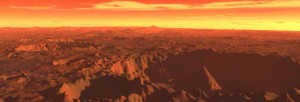
Mysterious Objects
The question of where Mars’ moons came from has caused a rift among scientists for many years, dating back to the early days of planetology. When viewed in visible light, Phobos and Deimos appear significantly darker than Mars itself, which adds credence to the theory that they were captured by the planet.
Scientists can analyze the mineral makeup of objects by using a spectrophotometer to separate the light they reflect into different colors and create distinct samples. By comparing these spectral samples to a library of spectra from known materials, researchers can determine the composition of remote objects. Most studies on asteroid composition have focused on visible light and near-infrared light, which falls outside of human perception.
In the range of visible and near-infrared light, Phobos and the D-class asteroids appear to be similar – their spectra are nearly devoid of distinguishing features, resulting in their dark appearance. D-class asteroids are as dark as coal due to their high carbon content. The dark characteristics of Phobos have led to the theory that the moon is a captured asteroid that came too close to Mars.
However, scientists who study the orbits of Mars’ moons suggest that they may not have been captured. It is possible that the moons formed concurrently with Mars or were the result of a significant impact on the planet during its formation over millions of years.
“According to Glotch, individuals who possess knowledge of orbital dynamics and understand the reasons behind the rotation of certain celestial bodies would argue that capturing Phobos is essentially impossible due to its inclination and orbit specifics. There is a discrepancy between the findings of spectroscopes and dynamists,” Glotch points out.
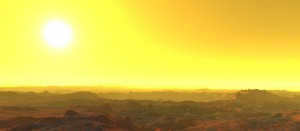
Investigating Heat Signatures
Glotch decided to approach the issue from a different perspective: using mid-infrared detection, which operates in the same temperature range as the human body. He analyzed the heat patterns emitted by Phobos, using data captured in 1998 by a device he affectionately refers to as the groovy thermometer, located on the Mars Global Surveyor spacecraft. While the primary mission of the robotic vehicle was to study Mars, it also managed to capture a glimpse of Phobos during its close encounters with the moon.
Thermal energy, similar to visible light, can be broken down into a range of “colors”. Even objects that appear black to the human eye can emit a distinct infrared spectrum. Despite Phobos’ frigid temperatures, it exhibits a unique thermal signature.
Glotch and his students conducted a comparison between the average infrared spectrum of Phobos, which was recorded by the Mars Global Surveyor, and samples of meteorites that fell near Tagish Lake in British Columbia. Some scientists speculate that these meteorites were fragments of a D-class asteroid. In order to simulate the extreme temperature fluctuations experienced by Phobos in the airless space, the researchers subjected the samples to a cold vacuum environment while heating them from both above and below.
The results showed that the Tagish Lake meteorite does not bear resemblance to Phobos in the specified wavelength ranges. However, the meteorite closely resembles Phobos when compared to basalt, a common volcanic rock that forms the majority of the Martian crust. This discovery led Glotch and his team to believe that Phobos may be a remnant of a past impact event in Mars’ early history.
The crust of the planet is baked
The latest research does not claim that Phobos is entirely composed of material from Mars, but the recent findings suggest that the moon contains some of the planet’s crust. This could be due to the fusion of debris from the planet with remnants of the impactor.
Frys, who was not involved in this study, notes that the Tagish Lake meteorite is unique in its own way and may not be the best example of a D-class asteroid to compare with Phobos. Frys also adds that the new study will not provide a definitive answer because Phobos is affected by space weathering, which alters the reflected spectrum and is challenging to replicate in the laboratory.
Deimos, one of Mars’ two natural moons, could have originally been an asteroid that was pulled in by the gravitational force of the Red Planet, or it might have been a piece that broke off from a larger celestial body due to a collision with Mars.

The discovery of the satellite Deimos
Asaph Hall of the Washington Naval Observatory is credited with the discovery of the object in 1877. Just six days later, he also discovered the second Martian moon, Phobos.
How Deimos got its name
Deimos was named after the ancient Greek deity of horror, who was the son of the god of war Ares. In ancient Greece, Phobos, Deimos’ twin brother, symbolized fear and gave rise to the word “phobia”. The decision to name the satellites after these “scary” characters is fitting, considering that the planet itself is named after the Roman god of war.
Orbital characteristics
The satellite’s orbit is nearly circular and is located approximately along the equator of Mars. Deimos is the outer of the two Martian moons, with an average distance from the center of the Martian system of 23,500 km. Its orbital speed is 1.5 times slower than that of Phobos, at less than 4 km/s.
The satellite takes 30 hours and 17 minutes to complete one rotation around its axis, according to terrestrial calculations.
It is in a gravitational lock with Mars, meaning that only one side of the satellite is always visible from the surface of the Red Planet.
It is believed that Phobos will eventually crash into its planet as it is getting 1.8 meters closer every century. Conversely, Deimos is slowly moving away from Mars at a rate of 9 centimeters per year and may eventually escape its orbit and enter into unrestricted motion.
Distinctive physical features
In support of the hypothesis that Deimos originated from an asteroid drawn in by Mars’ gravity or as a fragment of a former celestial body that disintegrated in a collision, its shape is excessively irregular. The satellite is distinguished by its relatively small size. Its measurements are 15x12x10 km, with an average radius of 12 km. Its mass amounts to merely 1.5 trillion tons.
Deimos lacks an atmosphere and a magnetic field. Surface temperatures can drop to as low as -40°C.
The relief of the object is not complex. Its surface is relatively flat, with a few depressions and elevations, but none of them exceed 20% of the average size of the satellite.
Natural moons with weak gravity, like Deimos, exhibit fractures and cracks caused by various factors:
- Due to the harmful effects of cosmic radiation;
- due to the influence of the solar wind;
- from collisions with stray celestial bodies.
However, Deimos does not have such surface defects, which can be attributed to its significant distance from Mars. The sedimentary dust that rises into space from comet and asteroid impacts settles on the satellite’s surface in a uniform layer.
Formation and composition
The creation and makeup of something.
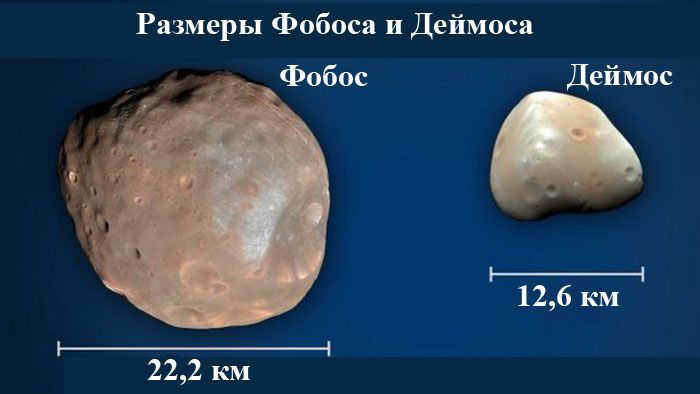
The moon of Mars, known as Phobos, is made up of a combination of ice and carbon-rich rocks, with an average density of about 1.5 g/cc.
Scientists are still uncertain about the origin of this satellite.
There are two main theories regarding the formation of this celestial body:
- Phobos and Deimos are believed to be two fragments of a larger object that was destroyed either by the gravitational force of Mars or in a collision with Mars or another celestial body. This theory is supported by the similarity of the soil on both moons, their rotational nature, and their geological structure.
- Deimos is a celestial object that was “captured” by Mars after breaking away from the Asteroid Belt due to the gravitational pull of both the Red Planet and Jupiter.
Currently, none of these theories has been definitively proven or disproven, and as a result, the scientific community has not fully embraced any of them.
The satellite’s surface is characterized by the presence of craters, although they appear smoother compared to those on Phobos due to the partial filling with a porous mineral regolith.
The two largest craters on Deimos are named Swift and Voltaire, with diameters of 1 and 1.9 kilometers, respectively. These names were chosen as a tribute to the writers who mentioned the existence of Mars’ two natural moons in their works prior to their discovery by astronomers.
No other craters on Deimos have been officially named at this time.
A representation of the topography of Deimos, a satellite
As far back as 1894, an initial estimation of the surface features of Deimos was created. The most recent and comprehensive photographs were taken in the early 2010s. The Curiosity rover, while exploring Mars, captured these images.

Observing Deimos from Mars
When standing on the surface of Mars, the inhabitants of the planet are able to observe this satellite during the night as a distant planet or a shining star, and during the day as a radiant point of light. This is similar to how humans on Earth see Venus in their own sky. If a Martian possessed a small telescope, they would be able to detect the ever-changing phases of Deimos, which occur almost daily. However, from regions on Mars that are positioned above latitude 82.7°, this moon would be out of sight.
The satellite Deimos spins at a lower speed compared to its counterpart Phobos. It ascends in the eastern part of Mars and descends in the western region. From the Martian surface, it is also possible to observe Deimos passing between the planet and the Sun. However, due to its small size, Deimos is unable to cause a complete solar eclipse and instead appears as a small black dot moving across the solar disk.
It is not rare to witness both Phobos and Deimos in the Martian sky simultaneously, and their trajectory will bring them closer to each other.
The initial images of this celestial body were captured by Russian astronomers A. Belopolsky and S. Kostinsky using a telescope. Kostinsky took these photos in the late 19th century, while G. These images not only provided insights into the appearance of Deimos, but also allowed for the determination of its trajectory and the creation of the first surface map. Subsequent research in the 20th century utilized more advanced technologies.
Over the years, the satellite has been observed by various missions:
– In 1971, NASA’s Mariner 9 spacecraft conducted observations.
– In 1976, the Viking 1 and 2 stations captured data.
– In 2011, the Mars rover “Curiosity” also contributed to the study.
Currently, investigations of Deimos primarily involve photography and videography, as more extensive research is not a primary focus for scientists.





